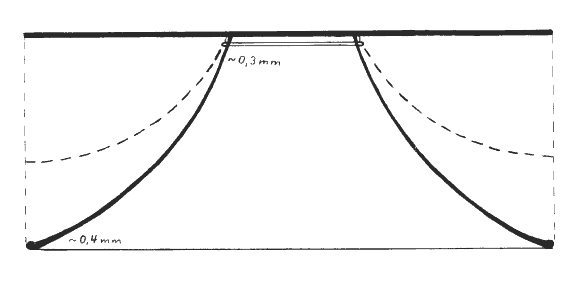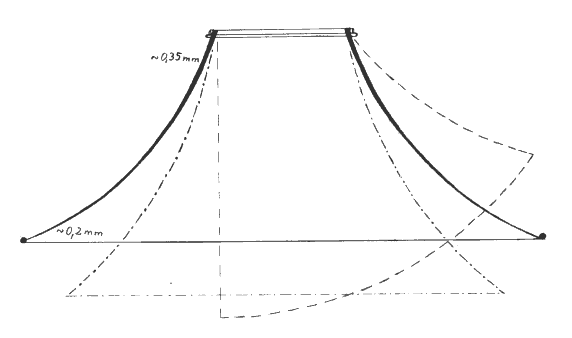Different bells and their effect on the sound
Bell sizes:
We describe the characzeristics of the 2 main bell sizes medium and wide.
Medium (m): an elegant, clear, carrying tone has advantages in the high range over the wide bell.
Wide (w): a full, but not dull, carrying sound, sonorous. With a carefull hand position, (straight and not too far out), it is possible to compensate for the disadvantages in the high range.
You also have the choice between 4 alloys:
Brass (MS): elegant, bright (nevertheless rich), smooth tone colors from sweet to extremely brassy. The alloy most versatile in sound. Those with an embouchure producing a naturally dark sound should choose brass. For approximately 80 % of hornplayers is MS the right choice. Strongly alkaline saliva can cause pitting with brass alloy. For this reason the mouthpipes on brass horns are made of nickel silver.
Gold Brass (GM): a bit smoother and darker, but clear, round and rich. Not as many tone colors are possible as with brass. Some embouchures sound a bit shallow with plain brass and need gold brass. Resistant to saliva. Some prefer gold brass simply because of the noble tone color.
Nickel silver (NS): contains no silver. The nickel portion of the alloy gives it its color. The sound is very dark in piano and very bright in fortissimo. Is an option only with wide and extra wide bells. In Europe the sound of nickel silver is not considered as noble as the other alloys. In America there is a tradition of nickel silver horns, but which is steadily decreasing. NS is permanently resistant to saliva.
Sterling Silver (SS): contains 92.5 % pure silver, the rest is copper. Engelbert Schmid is the only one, up to now, who has been able to produce thin walled sterling silver horn bells with a width of 310 mm. The sound is especially round so that the middle size is sufficient for most horn players. Sounds noble and doesn´t get too aggressive or edgy in fortissimo. It speaks very easily in piano with a rounded sound, (ideal for lyrical passages). In fortissimo the sound stays round but is more tiring to play than the other alloys. Is resistant to saliva and the only alloy resistant to sweat. Beautiful to look at, especially with a gold brass garland. We also offer instruments with all the conical parts made of sterling silver, (mouthpipe, bell branch and bell). The cylindrical parts are made of gold brass.
The alloy of the bell affects the sound characteristic to around 60 %. In other words a brass horn with a gold brass bell sounds more like a gold brass horn than a gold brass horn with a brass bell.
With or without garland?
With a weight of only 60 grams, the tastefully decorated garland from Engelbert Schmid does not deaden the sound. The garland causes a bit more resistance, and a somewhat rounder sound that gets brassy later, but more suddenly. Without the garland the transition to a brassy sound is more even. About 20 % of hornplayers sound better with the light garland from Engelbert Schmid.
Spun or hand hammered?

Spun
Of course we use a special method to keep the difference to a minimum, but it cannot be completely avoided.
Our hand hammered bells are cut out of one piece of metal bent into shape and at Engelbert Schmid soldered on one seam without "Zwickel". They are then hammered into the symetrical shape. Only in the last operation are they put on the press bank and, by turning and pressing, fitted exactly to the bell form. Because of the necessary stretching of the material due to the flare of the bell it becomes thinner towards the edge of the bell. At the screw ring it stays thicker than a spun bell and therefore is more resistant to sweat.

Hand hammered
Because hand hammered bells without a garland can be bent easily, you should not lift the horn by the edge of the bell. With Engelbert Schmid bells it is no problem to restabilize a bent bell edge. Stability was probably the original reason for adding garlands, not sound. Hand hammering stresses the material to a great extreme, which changes the structure, and definitely changes the sound a bit. The crucial factor is that the material becomes thinner towards the end, farther from the energy source, and therefore vibrates better with the sound. A hand hammered bell sounds more old fashioned, darker, than a spun bell. The thin end of the bell produces a very warm center to the tone in piano, and at the same time a more pleasant brassiness in fortissimo. The hand hammered bells are available with or without garland.
As far as I know, we are the only ones to offer so thin a bell with a width of 310 mm. Even an increased thickness of 0.05 mm makes the instrument harder to play and less flexible. A hand hammered bell must be very thin. Just about everyone who has a chance to compare prefers the hand hammered bell to the spun one.
Fixed or screw bell?
The fixed bell is esthetically preferable, but is much harder to transport, is harder to repair, and robs the hornplayer of the possibility of changing the sound with different sizes of bells. There is almost no difference in sound because the hand dampens the vibrations in the area of the screw ring anyhow. Our screw ring weighs only 100 g and still is very stabil.
Lacquered or unlacquered?
It is not possible to say that lacquer does not affect the sound. With a thickness on the inside and outside of 0.02 mm, this plastic-like covering accounts for approx. 10 % of the total material. Unlacquered sounds a bit more centered, which some people find brighter, some darker, some smoother and some harder. My observation and feeling is that lacquer dampens the high overtones, and also the extraneous noise in the sound, causes the horn to sound clearer, for some brighter, although it is acoustically darker. My experience is that the difference is minimal and that 50 % of hornplayers sound better on a lacquered instrument. The lacquer is more resistant to sweat than the metal and the horn will last longer if it is carefully polished when it is relacquered. It also prevents your hands from turning green. A shiny horn also makes a better impression on the audience. In my eyes the advantages of a lacquered horn clearly outweigh the disadvantages. The combination screw bell/lacquered sounds good, perhaps even better. It is definitely not important for a hornplayer´s tone. The deciding factor is the players concept of sound.